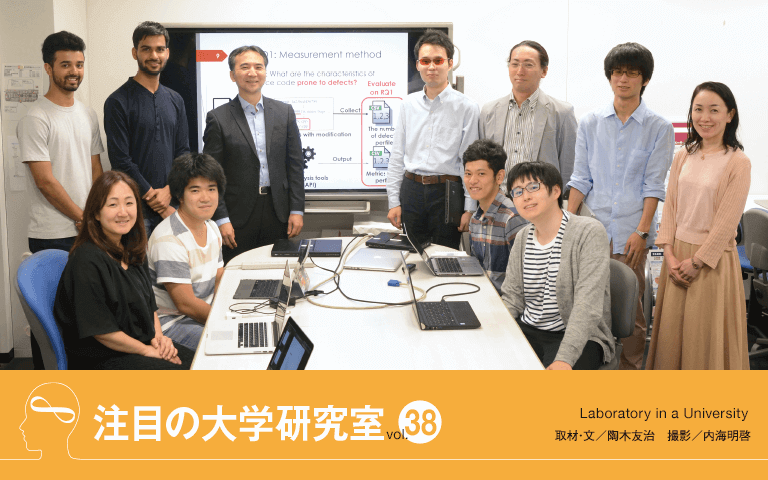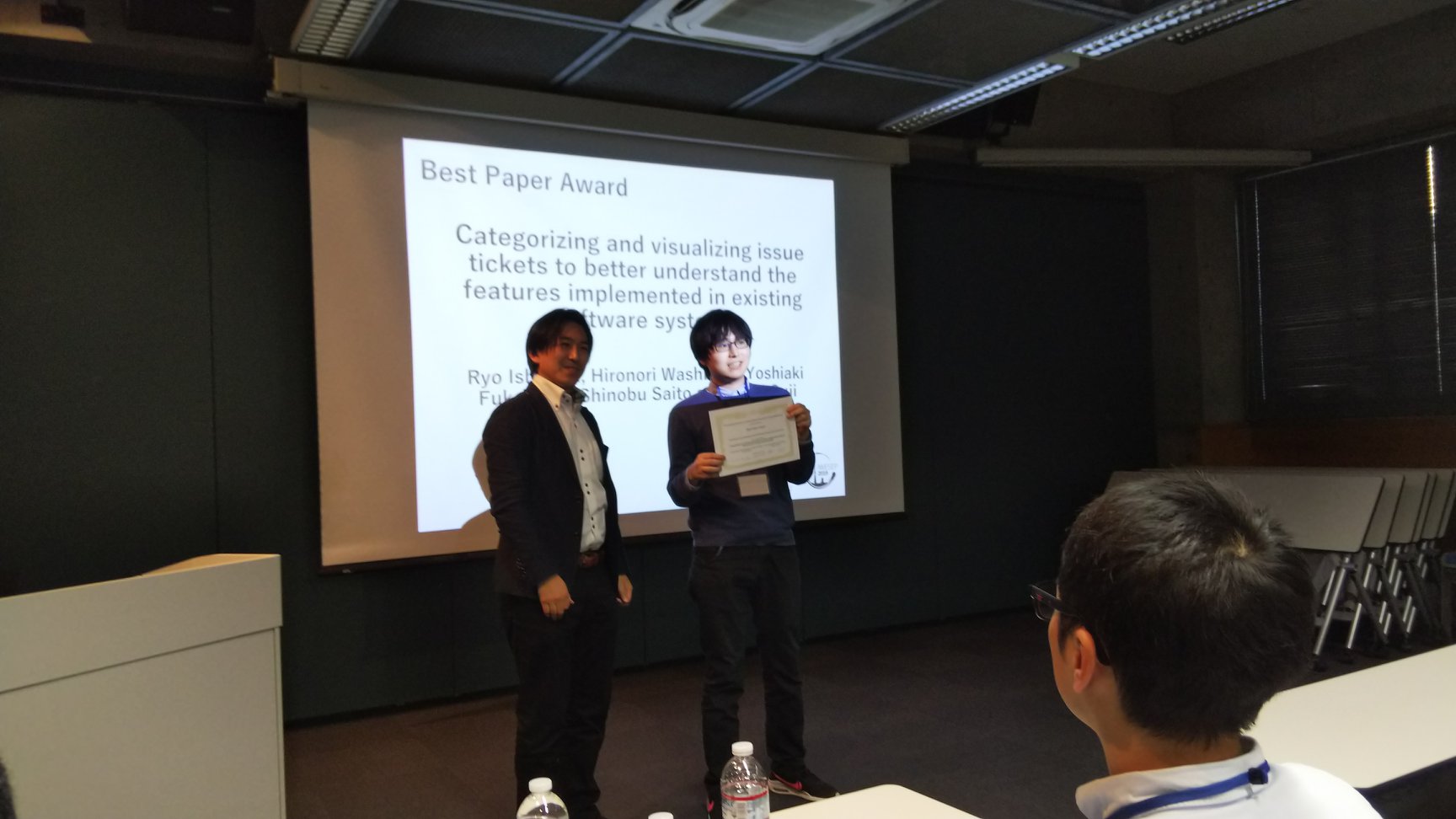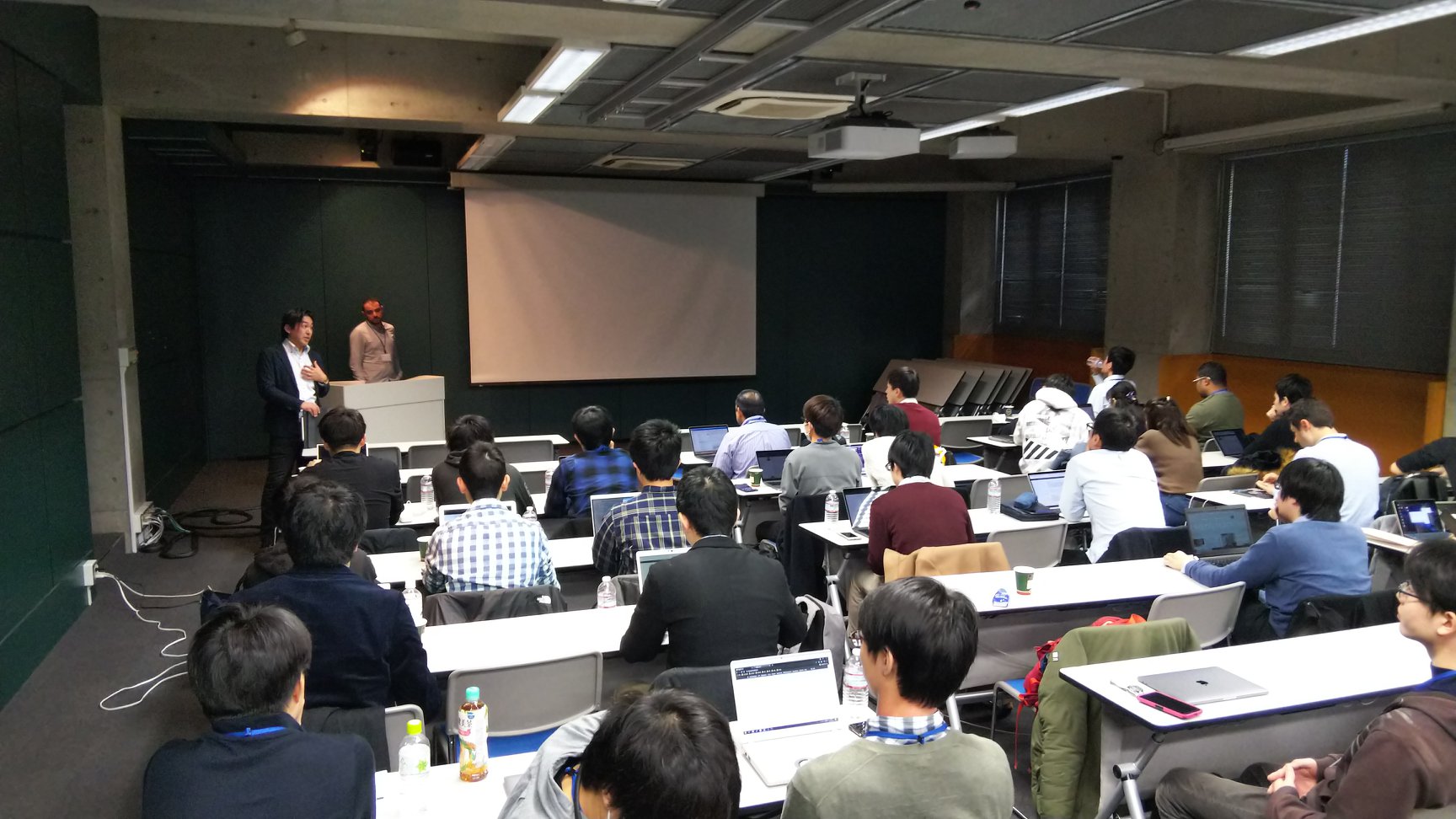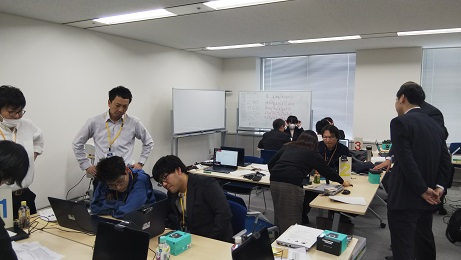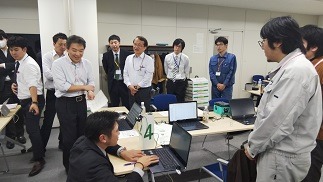マイナビさんのメディアにて書籍を取り上げていただきました。プログラミング的思考を伸ばそう『Scratchでたのしく学ぶプログラミング的思考』|Tech Book Zone Manatee
Software Engineering Patterns for Machine Learning Applications (SEP4MLA) accepted for AsianPLoP 2020
Hironori Washizaki, Foutse Khomh, Yann-Gael Gueheneuc, “Software Engineering Patterns for Machine Learning Applications (SEP4MLA),” 9th Asian Conference on Pattern Languages of Programs (AsianPLoP 2020), March 4-6, 2020, Taipei, Taiwan
Secure Distributed Publish/Subscribe (P/S) pattern for IoT, accepted for AsianPLoP 2020
Eduardo B. Fernandez, Nobukazu Yoshioka, Hironori Washizaki, “Secure Distributed Publish/Subscribe (P/S) pattern for IoT,” 9th Asian Conference on Pattern Languages of Programs (AsianPLoP 2020), March 4-6, 2020, Taipei, Taiwan
鷲崎教授が浜松HEPTフォーラムにて「超スマート社会時代の技術とenPiT-Proスマートエスイーにおける人材育成」講演、静岡新聞・浜松ケーブルテレビ ご紹介
Improving Syntactical Clone Detection Methods through the Use of an Intermediate Representation accepted for IWSC 2020
Pedro Caldeira, Kazunori Sakamoto, Hironori Washizaki, Yoshiaki Fukazawa and Takahisa Shimada, “Improving Syntactical Clone Detection Methods through the Use of an Intermediate Representation,” 14th International Workshop on Software Clones (IWSC 2020), 18 February 2020, London, Ontario, Canada, in conjunction with SANER 2020
配属先研究室を検討している現3年生(2020年4月 新4年生)ならびにプロジェクト研究検討の皆さんへ
以下の日時にオンラインで教員や学生から研究内容や研究室の様子を紹介し、さらに皆さんからの質問に教員や学生が答えますので、以下のリンクをクリックしてぜひ気軽に参加してください。加えて個別面談希望に対応できますので、希望者は washizaki[at]waseda.jp まで連絡してください。また、LINE 上で鷲崎教授や研究室大学院生が質問を受け付けますので、気軽に質問してください: 鷲崎研 LINE 質問箱 。また以下にあげる研究室紹介や動画も参考にしてください。
- オンライン説明会1: 3月20日(金・祝) 13:00, 15:00 @ Skype for Business
- 追加オンライン説明会(教員からの紹介): 3月22日(日) 17:30, 18:30 @ Skype for Business (追加)
- オンライン説明会2: 3月23日(月) 13:00, 15:00 @ Bb Collaborate (URL変更済み)
- 【大学研究室Vol.38】ビジネスと社会のためのソフト工学研究。最先端のクラウド、IoT、機械学習技術も含めた高信頼ソフトウエアを正しく実現
Washizaki-lab will hold virtual open house on Mar 20th and 23rd 1:00pm/3:00pm. Everyone is welcome. Also feel free to ask any question or individual visit request at washizaki [at] waseda.jp
Virtual Open House 1: Mar 20 1:00pm and 3:00pm @ Skype for Business
Virtual Open House 2: Mar 23 1:00pm and 3:00pm @ Skype for Business
鷲崎研究室 Washizaki laboratory: 日本語資料、Laboratory Introduction、プログラミング言語・環境、システム&ソフトウェア設計・再利用・品質保証・セキュリティ、AI・クラウド・IoT、プロジェクトマネジメント、組織目標・戦略、情報システム・プログラミング教育
- Keywords: Programming Languages and Environments, Systems and Software Design, Reuse, Quality Assurance and Security, AI, Cloud and IoT, Project Management, Organizational Goals and Strategies, Information Systems and Programming Education
New Year’s Resolution 2020
In below, I review the last year’s resolution 2019 and describe New Year’s Resolution 2020 in terms of Projects, Achievements, Community and Professional Contributions, and Team Organization. Japanese version is also available.
Highlights
2019: 15 projects incl. SmartSE and SE4BS. 12 journal papers, 24 int’l conf. papers and posters, 2 magazine articles, 1 book, and 44 talks. COMPSAC/SISA’19 PC Co-Chair, AsianPLoP’19 General Chair, IEEE CS PEAB Engineering Discipline Chair, IEEE CS Tokyo/Japan Chapter Chair, APSEC Steering Committee Member, Society for Research on Work Competency Director, and COMPSAC Advisory Committee Member, and associate editors of IEEE Trans. Emerging Topics in Computing, IJSEKE and Heliyon. Associate Dean of Research Promotion Division of Waseda University. Continuation: Outside Directors of SYSTEM INFORMATION and eXmotion.
2020: 15+ funded projects, 7+ journals, 20+ int’l conf. papers. SISA’20 PC Co-Chair, AsianPLoP’20 General Chair. Smart SE consortium research WG. SE4BS outreach. Continuation: Associate Dean of Research Promotion Division of Waseda U., Outside Directors of SYSTEM INFORMATION and eXmotion. Leading SWEBOK V4 evolution project.
Projects
2019: We successfully conducted the following 8 projects including Smart SE and SE4BS in 2019. In addition, we continued 7+ industrial funded projects with industrial partners. We extended our international research connections incl. Florida Atlantic University, Ecole Polytechnique de Montreal, Concordia University and Hillside Group.
- Smart SE: Smart Systems and Services innovative professional Education program 2017- (funded by MEXT Education Network for Practical Information Technologies: enPiT-Pro): Establishing advanced and practical education program and related research collaboration network in the area of AI, IoT and business involving 5000+ companies. 30 engineers took the program. 25,000+ registered themselves to the online course. We also provided a part of the program to professional engineers at Kanazawa and companies Hitachi and NEC.
- GQM-RG: Goal-oriented Qualitative/Quantitative Measurement and Management Research Group 2013-: Applied and extension researches on GQM+Strategies and related approaches. We prepared a new research WG (starting on 2020 Jan) on Business Strategies and Requirements at the Smart SE consortium.
- CSPM: Cloud Security and Privacy knowledge Metamodel 2015-2019 (funded by SCAT): Developing common metamodel for representing and organizing knowledge of security, privacy and transparency in cloud, fog and IoT computing.
- TraceANY 2016-2021 (funded by JSPS KAKENHI: Grants-in-Aid for Scientific Research (B)): Tracing any software artifacts at any abstraction levels based on common metamodels including Program Metamodel TAxonomy (ProMeTA).
- Waseda Software Quality Benchmark 2015- (funded by IPA/SEC RISE: Research Initiative on Advanced Software Engineering): SQuaRE-based comprehensive quality evaluation of software products. Its achievement has been presented at ICSE 2019 SEIP.
- G7 Programming Learning Summit 2016- and Regional ICT Club 2018-2019 (funded by MIC): We wrapped up the IoT programming education program for kids in Ota yard and Sayama city. In relation, we published a book about Computational Thinking for Kids.
- Software Engineering for Business and Society (SE4BS): We started new project to establish a methodology in Digital Transformation era to link society, business, software engineering and related disciplines including design thinking.
- Software Engineering and IoT/Machine Learning (funded by JST and TTC): We joined JST QAML project to research on ML engineering practices and processes. We investigated state-of-the-art of IoT, AI and systems and software engineering supported by TTC. In relation, we invited two professors Prof. Yann and Prof. Foutse to conduct joint research on Software Engineering ML patterns and other related topics including empirical software engineering for software design and architecture. We also had an exchange student to proceed with IoT and Software Engineering.
2020: We will make this year with significant advance by continuing and expanding all of the above-mentioned 8 projects in 2020. Especially, we will more proceed with Smart SE research WG, Programming Education Project, SE4BS, and SE and ML/IoT. Also we will continue 7+ industrial funded projects with industrial partners.
Achievements* (List of publications)
2019: We published 12 papers for good or prestigious journals including IEEE Access, IEEE IoT Journal and Springer TPLoP. We presented 23 international conference and workshop papers (incl. 1 at CORE Rank A* conference, 3 at Rank A, 3 at Rank B, and 2 at Rank C), 1 international conference poster, 2 magazine articles, 1 book, and 44 talks incl. 1 keynote. Our activities have been reported so frequently in many news medias including Nikkei News Paper.
We received awards incl. IWESEP Best Paper Award, IMS Japan Award, Japan e-Learning Award and IPSJ-SIGSE Excellent Research Award. On 1st Jan 2019, Prof. Washizaki stated that we aimed to publish 7 journal papers (incl. 4+ international) and 20 international conference and workshop papers (3+ at CORE Rank A/A* and 5+ at Rank B). We successfully achieved the goal of number of papers stated. Of course, we believe we can do better and more in 2020.
2020: Having the similar but extended clear vision stating that “smart systems and software engineering for people and society by connecting AI, IoT and software engineering”, we will push forward with research on smart, novel and actionable software and systems engineering methods and tools based on well-defined and validated theory to contribute to software and systems engineering industry and academia in collaboration with 10+ local and global partners. We continue to acquire large funds. We aim to publish impactful papers at better places: at least 7 journal papers (incl. 4+ international) and 20 international conference papers (3+ at CORE Rank A/A* and 5+ at Rank B/C). Many of our research achievements in the form of methods, practices and tools shall be continuously used and produce actual values through our local and global partners.
Community and Professional Contributions
2019: Thanks to many collaborators and supporters, we hosted and/or organized various conferences and meetings including AsianPLoP 2019, COMPSAC/SISA 2019, ET Robocon 2019 Tokyo Regional Contest, XP Matsuri 2019, Programming/IT Camps at Waseda with Life is Tech, and IPSJ SamurAI Coding 2018-19. For these events, Prof. Washizaki played key roles such as PC Co-Chair of COMPSAC/SISA 2019 and General Chair of AsianPLoP 2019 to contribute to the outer world and expand our network. Prof. Washizaki continued to serve as ISO/IEC/JTC1 SC7/WG20 Convenor, IEEE CS PEAB Engineering Discipline Chair, CSEE&T Steering Committee Member, IEEE CS Tokyo/Japan Chapter Chair, APSEC Steering Committee Member, Society for Research on Work Competency Director, COMPSAC Advisory Committee Member, Associate Dean of Research Promotion Division of Waseda University, Outside Director of SYSTEM INFORMATION CO., LTD., Outside Director of eXmotion Co., Ltd., Technical Adviser of GAIO TECHNOLOGY Co., Ltd., and associate editors of IEEE Trans. Emerging Topics in Computing (TETC), International Journal of Software Engineering and Knowledge Engineering (IJSEKE) and Heliyon. In addition, Prof. Washizaki initiated SWEBOK V4 evolution project.
2020: We will host and/or organize various conferences and meetings including AsianPLoP 2020, IEEE COMPSAC/SISA 2020, ET Robocon 2020 Tokyo Regional Contest and IPSJ SamurAI Coding 2019-20. For these events, Prof. Washizaki will play key roles such as PC Co-Chair of COMPSAC/SISA 2020 and General Chair of AsianPLoP 2020 to contribute to the outer world and expand our network. Prof. Washizaki continue to serve as ISO/IEC/JTC1 SC7/WG20 Convenor, IEEE CS PEAB ED Chair, APSEC Steering Committee Member, CSEE&T Steering Committee Member, Society for Research on Work Competency Director, Associate Dean of Research Promotion Division of Waseda University, Outside Director of SYSTEM INFORMATION CO., LTD., Outside Director of eXmotion Co., Ltd., Technical Adviser of GAIO TECHNOLOGY Co., Ltd., leader of SWEBOK V4 evolution, and associate editors of TETC, IJSEKE and Heliyon.
Team Organization
2019: We had new international exchange student from Canada in 2019.
2020: Like last year, we expect some new students coming from various countries. Our team is growing and having more diversity in national origins, backgrounds and mindsets. Such diversity contributes to our team in various aspects such as creativity to advance the above-mentioned projects and professional contributions.
January 1st, 2020
Hironori Washizaki
Associate Dean of Research Promotion Division, Waseda University.
Professor and Director of Global Software Engineering Laboratory, Waseda University
Visiting Professor, National Institute of Informatics
Outside Director, SYSTEM INFORMATION CO., LTD.
Outside Director, eXmotion Co., Ltd.
Technical Adviser, GAIO TECHNOLOGY Co., Ltd.
2020年の抱負
プロジェクト、業績、コミュニティ・プロフェッショナル貢献、チーム構成の観点から、以下に2019年を振り返り、2020年の抱負を述べます。英語版 English Version もあります。
ハイライト
2019: スマートエスイーおよびSE4BSを含む15助成・産学プロジェクト。論文誌論文 12、国際会議 24, 雑誌記事2, 書籍1, 講演44。COMPSAC/SISA PC Co-Chair, AsianPLoP General Chair, IEEE CS PEAB Engineering Discipline Chair, IEEE CS Tokyo/Japan Chapter Chair, APSEC Steering Committee Member, しごと能力学会 理事, COMPSAC Advisory Committee Member, IEEE Trans. Emerging Topics in Computing, IJSEKEおよびHeliyon編集委員. 早稲田大学研究推進部副部長, システム情報 取締役(監査等委員), エクスモーション 社外取締役.
2020: 新規を含む15+助成・産学プロジェクト。論文誌論文 7、国際会議20偏。SISA PC Co-Chair, AsianPLoP General Chair。スマートエスイー コンソーシアムWG活動。SE4BSアウトリーチ。SWEBOK V4策定リード。継続: 早稲田大学研究推進部副部長、システム情報 取締役(監査等委員)、エクスモーション 社外取締役.
プロジェクト
2019: 我々はスマートエスイーおよびSE4BSを含む以下の8プロジェクトを成功裏に立ち上げおよび継続しました。加えて企業パートナーとの7以上の共同研究プロジェクトを継続しました。Florida Atlantic University, Ecole Polytechnique de Montreal, Concordia Universityおよび Hillside Group を含む様々な海外パートナーとの研究連携を深めました。
- スマートエスイー: スマートシステム&サービス技術の産学連携イノベーティブ人材育成 2017-2021 (文部科学省 enPiT-Pro): AI・IoT×ビジネス分野のイノベーション人材を創出する社会人学び直し事業、13大学21組織、会員5000企業超と産学連携ネットワークを実現。2018年度に1期生30名が受講、約25,000名がオンライン講座を受講登録。コンソーシアムを通じて金沢および企業 日立製作所・NECへのオンサイト教育提供。
- GQM-RG: Goal-oriented Qualitative/Quantitative Measurement and Management Research Group 2013-: ゴール指向の定性/定量測定・マネジメントの調査研究 2013-: GQM+Strategiesおよび関連手法の実践および応用研究。2020年1月から始めるビジネス要求・戦略に関するスマートエスイーコンソーシアム調査研究WGの準備。
- CSPM: Cloud Security and Privacy knowledge Metamodel 2015-2019 (SCAT研究助成): クラウド・フォグ・IoTコンピューティングにおけるセキュリティ&プライバシの知識を表現および構成するための共通メタモデルの構築。
- TraceANY 2016-2021(科研費 基盤研究(B)): あらゆるソフトウェア成果物のあらゆる抽象度における追跡手法、およびそれを支えるプログラムメタモデルの分類 (ProMeTA: Program Metamodel TAxonomy)。
- Waseda Software Quality Benchmark 2015- (IPA/SEC RISE: ソフトウェア工学分野の先導的研究支援事業): ソフトウェア製品のSQuaREに基づく体系的な品質評価。成果をICSE 2019 SEIPにて発表。
- G7 Programming Learning Summit 2016- および総務省「地域におけるIoTの学び推進事業」実証事業ICTクラブ 2018-2019: 小学生を対象としたICTクラブ活動を大田区および狭山市を完了。成果を応用して書籍『Scratchでたのしく学ぶプログラミング的思考』(マイナビ)出版。
- ビジネスと社会のためのソフトウェア工学 (SE4BS): DX時代に必要な社会、ビジネス、ソフトウェア工学およびデザイン思考を含む関連領域を結びつける体系および方法論の整備に着手。
- ソフトウェア工学とIoT/機械学習 (部分的にJSTおよびTTC助成): JST未来社会QAML プロジェクトに参画し、機械学習(ML)エンジニアリングのプラクティスおよびプロセスの調査研究。TTC助成のもと、IoT/AIとシステムズ・ソフトウェアエンジニアリングの最前線の調査。関連してYann教授・Foutse教授を招聘しMLアーキテクチャ・デザインパターンおよび実証的ソフトウェア工学の共同研究。IoTソフトウェア工学について交換留学生の取り組み。
2020: 我々は本年をさらなる飛躍と展開の年と位置付け、上述の8プロジェクトを継続しつつ社会へより具体的に深く働きかける形で発展させます。特にスマートエスイーコンソーシアムにおける調査研究WG、プログラミング教育プロジェクト、SE4BS、ソフトウェア工学とML/IoTについて産学連携による研究、教育・人材育成、交流を展開します。また7以上の企業パートナーとの共同研究を継続発展させます。
業績 (研究業績一覧)
2019: 昨年我々は、12編の論文をIEEE Access, IEEE IoT JournalおよびSpringer TPLoPを含む優れた論文誌において発表しました。また、国際会議発表23編 (うちCORE Rank A*会議1編、Rank A 3編、Rank B 3編、Rank C 2編)、国際会議ポスター1件、学会誌記事2編、書籍1冊、および、基調講演を含む44件の講演機会を得ました。我々の活動は日本経済新聞を含む多くのメディアや会議において取り上げられました。IWESEP Best Paper Award、IMS Japan賞、日本e-Learning大賞、IPSJソフトウェア工学研究会卓越研究賞をはじめ多くの表彰を得ました。昨年1月1日に目標として掲げた数字は論文誌7編 (国際論文誌4編以上を含む)、国際会議20編 (うちCORE Rank A会議3編以上、Rank B会議5編以上)でした。全体として目標を達成したと自己評価します。無論、我々はこれに満足せず、常により良く、より多くの成果をあげていきます。
2020: 今年我々は、昨年からのビジョンを拡張したものとして「AI・IoTとソフトウェア工学の接続による人々と社会のためのスマート・システム&ソフトウェアエンジニアリングの実現」を掲げて、10以上の産業界・学術界パートナーと協調しながら、大規模な競争的資金を獲得しつつ研究を進めます。理論に裏打ちされた独創的、アクショナブルかつスマートなソフトウェア・システムズエンジニアリング手法・ツールにより、産業界および学術界に貢献します。よりインパクトのある論文をより良い場所で発表します。具体的には、論文誌7編 (国際論文誌4編以上を含む)、国際会議20編 (うちCORE Rank A/A* 会議3編以上、Rank B/C会議5編以上)を目標とします。我々の研究成果の多くが手法、プラクティス、ツールといった形で、研究パートナーとの連携を通じて引き続き実際に用いられ実質的価値を生み出していくことを追求します。
コミュニティ・プロフェッショナル貢献
2019: 多くのご支援ご協力の元、次にあげる多くのプログラミング・エンジニアリングコンテストを開催あるいは開催に貢献してきました: AsianPLoP 2019, COMPSAC/SISA 2019, ETロボコン2019東京地区大会, XP祭り2019, Life is Tech!と連携したプログラミング・ITキャンプ、IPSJ SamurAI Coding 2018-19. 鷲崎教授はそれらの機会に主要な役割を果たしました: COMPSAC/SISA 2019 PC Co-Chair, AsianPLoP 2019 General Chair. さらに鷲崎教授は次にあげる多くの重要な役割により学協会や社会へと貢献しました: ISO/IEC/JTC1 SC7/WG20 Convenor, IEEE CS PEAB Engineering Discipline Chair, CSEE&T Steering Committee Member, IEEE CS Tokyo/Japan Chapter Chair, APSEC Steering Committee Member, しごと能力学会 理事, COMPSAC Advisory Committee Member, IEEE Trans. Emerging Topics in Computing (TETC), International Journal of Software Engineering and Knowledge Engineering (IJSEKE)およびHeliyon編集委員, 早稲田大学研究推進部副部長、株式会社システム情報 取締役(監査等委員)、株式会社エクスモーション 社外取締役、ガイオ・テクノロジー株式会社 技術アドバイザ。また、鷲崎教授はSWEBOK V4 策定プロジェクトを立ち上げました。
2020: 今年我々は引き続き、次を含む多くの会議の開催や運営に貢献します: AsianPLoP 2020, IEEE COMPSAC/SISA 2020, ETロボコン東京地区大会、IPSJ SamurAI Coding 2019-20. これらのイベントやコミュニティの開催や開催支援を通じて我々は研究成果を発信し、外部社会へと貢献するとともに繋がりを広げていきます。鷲崎教授はCOMPSAC/SISA 2020 PC Co-Chair, AsianPLoP 2020 General Chair, ISO/IEC/JTC1 SC7/WG20 Convenor, IEEE CS PEAB ED Chair, APSEC Steering Committee Member, CSEE&T Steering Committee Member, しごと能力学会 理事, 早稲田大学研究推進部副部長、株式会社システム情報 取締役(監査等委員)、株式会社エクスモーション 社外取締役、ガイオ・テクノロジー株式会社 技術アドバイザ, SWEBOK V4策定リーダ, TETC, IJSEKEおよびHeliyon編集委員として計算機科学全般およびソフトウェア・システムズエンジニアリング領域における研究・産業の発展、コミュニティ醸成および標準化をリードし貢献します。
チーム構成その他
2019: 新たにカナダから交換留学生が加わりました。
2020: 今年も引き続き様々な国々からの留学生の参加を期待しています。多様な背景、文化、マインドセットを持つメンバが集うことで、我々のチームは創造性を含む様々な面でより強化され、上述の研究プロジェクトやプロフェッショナル貢献を強力に推し進めます。
2020年1月1日
鷲崎 弘宜
早稲田大学 研究推進部 副部長
早稲田大学 グローバルソフトウェアエンジニアリング研究所 所長・教授
国立情報学研究所 客員教授
株式会社システム情報 取締役(監査等委員)
株式会社エクスモーション 社外取締役
ガイオ・テクノロジー株式会社 技術アドバイザ
“Categorizing and visualizing issue tickets to better understand the features implemented in existing software systems” got Best Paper Award at IWESEP 2019
Our paper titled “Categorizing and visualizing issue tickets to better understand the features implemented in existing software systems” got Best Paper Award at IWESEP2019. Congrats, Ryo! Joint research with NTT. Thanks to Saito-san and Ouji-san for this opportunity. And thanks to all organizers and chairs to hold the great workshop.

